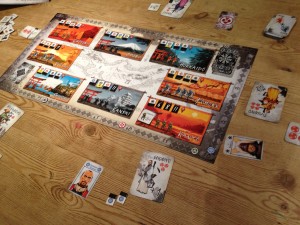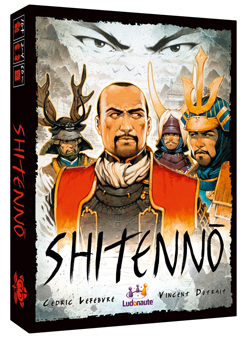Review: Shitenno
Posted by James (admin) on September 13th, 2012
 Shitenno is designed by Cédric Lefebvre whose previous games (Yggdrasil and Offrandes) have been really good. Shitenno is a game set in feudal Japan which mixes a you-cut-I-decide mechanic with area control. Each round, 2 troop cards and 1 income card per player are drawn face-up – the first player in turn order is the Tairo who selects any number and mix of the cards and offers them to the other players (in turn order) along with one of the 4 role cards. A player can accept or refuse the offer – if a player accepts, they take the cards and role and can not accept any more cards that round, then the Tairo selects a new mix of cards and a role to offer to the remaining players who have yet to accept an offer that round. If no other player accepts an offer, the Tairo must take the cards and role themselves (and the next player in turn order who has not accepted an offer becomes the Tairo).
Shitenno is designed by Cédric Lefebvre whose previous games (Yggdrasil and Offrandes) have been really good. Shitenno is a game set in feudal Japan which mixes a you-cut-I-decide mechanic with area control. Each round, 2 troop cards and 1 income card per player are drawn face-up – the first player in turn order is the Tairo who selects any number and mix of the cards and offers them to the other players (in turn order) along with one of the 4 role cards. A player can accept or refuse the offer – if a player accepts, they take the cards and role and can not accept any more cards that round, then the Tairo selects a new mix of cards and a role to offer to the remaining players who have yet to accept an offer that round. If no other player accepts an offer, the Tairo must take the cards and role themselves (and the next player in turn order who has not accepted an offer becomes the Tairo).
Once each player has accepted some cards (the final player to accepts all that remains), the players now claim areas in turn order which is dictated by the role cards they received (and the roles also give other special abilities too).
The board has 8 regions and spaces for 4 control markers in each (which I shall call zones). Players get points for placing a control marker in a zone equal to the number printed on the zone – the zones must be claimed in order and players get more points the later they claim a zone in a region. The zones in some regions score more points than others, but these take more cards to claim them. As well as points for claiming zones, players will score extra points at the end of the game if they have the most control markers in a zone (with ties being split by whoever was there earliest).
To place a control marker, the player must discard troop cards that match those shown on the region. Each region shows 2 or 3 troops printed on it as well as one more troop shown on the top of a random stack of tiles in each zone. Alternatively, the player can place a control marker by discarding enough cash equal to the number marked on the zone. So, you can take control by force or by bribery.
When placing a control marker, the player takes the top tile in that region, so the troops required to place a control marker alter slightly as players claim zones. Also, each tile shows a special bonus power too which can be used once by its owner such as +1 to a troop card, exchange a troop for cash, take a free card. The game ends when any player has run out of control markers, or the cash card deck has run out, and the winner is the player with most points (after adding bonuses for having control of a region and for cash in hand).
 Overall, I like the I-cut-and-you-decide mechanic which is in games like Sahne and San Marco. However, Shitenno uses it in what feels like a new way – the process of the mechanic is the same but Shitenno surrounds it with different mechanics that work well. Using troops or cash to claim a zone is a nice mechanic too, as is the tile system to vary the requirements for each zone. The bonus tiles are important as they give you a clear edge, and I like how you get to see what bonus effect a tile will give you before you claim it as the bonus is shown on the front too. This all combines into a clever and clean design that fits together very neatly.
Overall, I like the I-cut-and-you-decide mechanic which is in games like Sahne and San Marco. However, Shitenno uses it in what feels like a new way – the process of the mechanic is the same but Shitenno surrounds it with different mechanics that work well. Using troops or cash to claim a zone is a nice mechanic too, as is the tile system to vary the requirements for each zone. The bonus tiles are important as they give you a clear edge, and I like how you get to see what bonus effect a tile will give you before you claim it as the bonus is shown on the front too. This all combines into a clever and clean design that fits together very neatly.
Being able to just buy a position in an area for enough cash was a nice alternate route, rather than have to have the exact troop cards required. This often cost a lot of cards but it meant all zones felt under potential threat which added tension because there was always the chance someone could take a position just by having enough cash.
The roles are important too as not only do they decide turn order (which is important when splitting the cards, but vital when claiming areas), but their special powers are powerful too. One of them allows its owner to make one of their control markers worth double, another gives +2 points when claiming a zone.
I was surprised how similar the 8 zones are and I expected more of a mix; however, I think this ensures that all cards are equal which would be easier to balance. As with many games, it can be a bit tricky to know what to do to start with because no-one has any control markers in zones, but this comes together quickly and you start to know where you want to focus your efforts and who you need to compete against.
There decision-making in selecting what cards and role to offer is very interesting as there is a lot to consider and balance. If there are some cards you specifically want, offering them early is good just in case no-one takes an offer that doesn’t include them because then you’ll get stuck with the cards you didn’t want; however, if you do offer the cards you want early, there are more players that might take them too, plus if you end up with the first offer, another player will be the person deciding how to split the cards that round. So, you need to construct offers that people will want but which won’t benefit them as much as you.
However, this process of constructing the offers creates the main downside to the game which can be quite a bit of downtime. Being the first player to make an offer in a 4-player game is quite daunting as there are 12 cards and 4 roles to consider. Plus, not only are thinking about what you want, but also what others want which is not easy to track. So, this interesting choice for one player means that all the other players have nothing to do in the meantime. It gets quicker as players accept offers and the remaining cards reduce.
Also, I found it quite difficult to work out what other players wanted which would enable me to know what not to give them, especially with regions I wasn’t involved in. So, I did feel I was only really trying to make me win and couldn’t work out how to hinder others.
The game looks good, although I realise I have some kind of mental block with any game set in feudal Japan because the designers always use the Japanese names for things which just adds an extra layer of deciphering, i.e. Kokus, Kamon, Bakufus meaning troops, markers, seals. I like that the theme is being used but, personally, I usually end up just calling things their English equivalent names.
In the end, I liked Shitenno even though there was quite a lot of downtime at the start of each round. (It’s the first game I’ve played where being the player constructing the offers is a strong position to be in, but some players are pleased when they aren’t that player because it’s such a big task.) I’m sure that would improve a but after more plays. I do want to play Shitenno some more and I would really like to try it out with 2 players because I think the downtime would be completely removed and you’d know more about your opponent’s potential plans. So, Shitenno is yet another good game from Ludonaute.
James.
[Played with 4 players]

